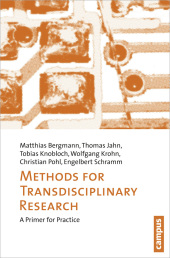 Neuerscheinungen 2013Stand: 2020-01-07 |
Schnellsuche
ISBN/Stichwort/Autor
|
Herderstraße 10
10625 Berlin
Tel.: 030 315 714 16
Fax 030 315 714 14
info@buchspektrum.de |

Matthias Bergmann, Ronald C. Faust, Thomas Jahn, Tobias Knobloch, Wolfgang Krohn, Christian Pohl
(Beteiligte)
Methods for Transdisciplinary Research
A Primer for Practice
Mitarbeit: Bergmann, Matthias; Jahn, Thomas; Knobloch, Tobias; Krohn, Wolfgang; Pohl, Christian; Übersetzung: Faust, Ronald C.
2013. 295 S. 24 Abbildungen, 3 Tabellen. 211 mm
Verlag/Jahr: CAMPUS VERLAG 2013
ISBN: 3-593-39647-5 (3593396475)
Neue ISBN: 978-3-593-39647-7 (9783593396477)
Preis und Lieferzeit: Bitte klicken
Die transdisziplinäre Forschung bearbeitet komplexe gesellschaftliche Probleme, indem sie Wissen und Methoden aus verschiedenen Fächern verknüpft und die Expertise von Praxisakteuren miteinbezieht. Die Autoren beschreiben systematisch wissenschaftliche Methoden für die Wissensintegration und geben Beispiele aus der Forschungspraxis.
Transdisciplinarity is an approach for research on the complex real-world problems our societies are facing. During the research process new knowledge is produced by integrating different problem perceptions and knowledge bases from sciences and societal practice; the aim is to contribute to both societal and scientific progress.
The authors systematically describe scholarly methods for the task of knowledge integration in transdisciplinary research and provide examples from research practice. This book supports scholars in the conceptualization and execution of transdisciplinary research projects and is of high relevance for teaching.
Contents
Preface to the English edition9
Julie Thompson Klein
Foreword to the English edition11
Matthias Bergmann
Introduction to the 2010 German edition13
Matthias Bergmann
Structure of the book and how to use it17
How to use the method collection and examples19
Chapter I: The integrative approach in transdisciplinary research22
Chapter II: Integration methods-An overview of individual methods for transdisciplinary research practice50
II.AIntegration through conceptual clarification and theoretical framing53
A.1 Integration through interdisciplinary conceptual work57
A.2 Integration through theoretical framing65
II.B Integration through research questions and hypothesis formulation73
B.1Integration through joint formulation of relevant research questions74
B.2 Integration through the formulation of hypotheses76
II.C Screening, using, refining, and further developing effective integrative scientific methods79
C.1 Integration through screening existing (inter)disciplinary methods and identifying methodical needs80
C.2 Integration through interdisciplinary development of methods82
C.3 Integration through adopting established transdisciplinary methods85
II.D Integrative assessment procedures89
II.E Integration through the development and application of models95
II.F Integration through artifacts, services and products as boundary objects105
F.1 Integration through artifacts, services and products106
F.2 Integration through publications112
II.G Integrative procedures and instruments of research organization115
G.1 Integration through the formation of interdisciplinary teams115
G.2 Integration through stakeholder involvement and participation124
G.3 Integration through iteration/recursiveness129
G.4 Integration through key question procedure at end of project132
Chapter III: Integration strategies-Examples of comprehensive concepts in research practice136
III.A Preliminary remark136
III.B Example 1: Strategies for a sustainable urban mobility-Integration through interdisciplinary method development137
B.1Framework conditions and project´s research goal137
B.2 Research strategy and integration methods139
B.3 Project brief150
III.C Example 2: Demography and supply systems-Integration through theoretical work and model development152
C.1 Framework conditions and project´s research goal152
C.2 Research strategy and integration methods154
C.3 Project brief169
III.DExample 2: Decline of fish populations-Integration through formulation of hypotheses with stakeholder participation172
D.1 Framework conditions and project´s research goal172
D.2 Research strategy and integration methods173
D.3 Project brief181
III.E Example 4: A reconception of grazingland management-Integration through inclusion of everyday action183
E.1 Framework conditions and project´s research goal183
E.2 Research strategy and integration methods184
E.3 Project brief190
III.F Example 5: Adapted health services for nomadic pastoralists-Integration through the inclusion of a target group192
F.1 Framework conditions and project´s research goal192
F.2 Research strategy and integration methods193
F.3 Project brief199
III.G Example 6: Sustainable housing renovation-Integration through including practice partners and through product orientation202
G.1 Framework conditions and project´s research goal202
G.2 Research strategy and integration methods203
G.3 Project brief209
III.HExample 7: Sustainability and urban design-Integration through cross-disciplinary categorial systems and iterative forms of work211
H.1 Framework conditions and project´s research goal211
H.2 Research strategy and integration methods213
H.3 Project brief219
III.I Example 8: Water demand forecast for Hamburg-Integration through continual design of the research process and operationalization of the product220
I.1 Framework conditions and project´s research goal220
I.2 Research strategy and integration methods222
I.3 Project brief


